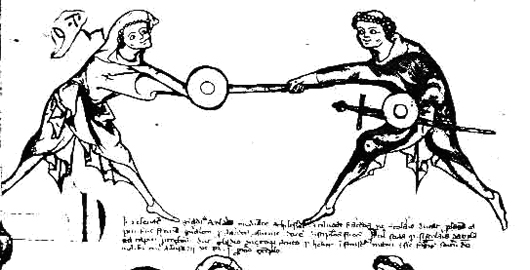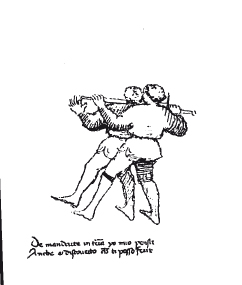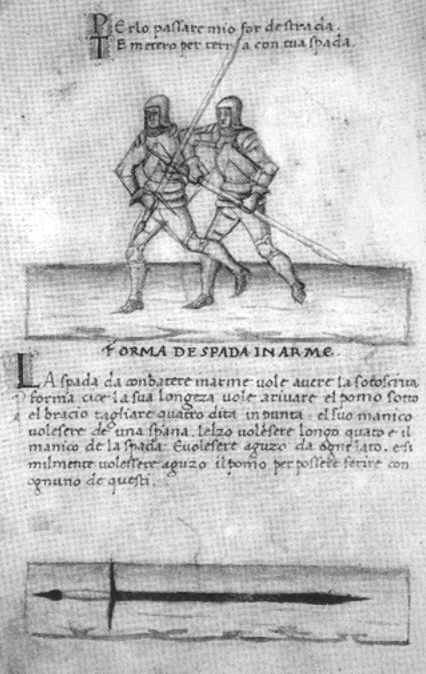| Author |
Message |
Maurizio D'Angelo

|
 Posted: Sun 21 Feb, 2010 12:38 pm Post subject: Filippo Vadi against D'Angelo Posted: Sun 21 Feb, 2010 12:38 pm Post subject: Filippo Vadi against D'Angelo |
 |
|
Hi all,
I returned to the subject of sharpening of swords, the term refers to 1400 -end 1500.
There are two sources, at first glance a contradiction in the other.
1) Filippo Vadi, he writes that the swords are not sharp on strong, but only on the weak. Speaks two-handed sword, 1450-1482
2) D'Angelo Viggiani-Schermo-1575 swords are sharpened on the strong to the tip.
Vadi was right or D'Angelo?
Against total armor, served sharpening the strong?
Some fencing techniques, suggest to hold the sword with his left hand. If it was sharp, it would be more difficult to hold it.
What we see, about two-handed sword, in the museums of that time?
Ciao
Maurizio
|
|
   |
 |
|
Kel Rekuta
|
 Posted: Sun 21 Feb, 2010 1:08 pm Post subject: Posted: Sun 21 Feb, 2010 1:08 pm Post subject: |
 |
|
Maurizio,
Vadi's sword description applies to a special weapon for tournament fighting. It might as well be a steel bar with a sharpened blade area near the tip. We can still find similar swords being used well into the sixteenth century.
Viggiani is talking about a stiff, narrow double edged sword for use in one hand. Different purpose, different design not really comparable.
|
|
   |
 |
Maurizio D'Angelo

|
 Posted: Mon 22 Feb, 2010 10:31 am Post subject: Posted: Mon 22 Feb, 2010 10:31 am Post subject: |
 |
|
| Kel Rekuta wrote: | Maurizio,
Vadi's sword description applies to a special weapon for tournament fighting. It might as well be a steel bar with a sharpened blade area near the tip. We can still find similar swords being used well into the sixteenth century.
Viggiani is talking about a stiff, narrow double edged sword for use in one hand. Different purpose, different design not really comparable. |
Can you explain better?
Are Vadi's swords equal Fiore's swords? Are special weapons are used only in tournaments? Are what are called "spade da zogo"? (translated "game-swords")
why special weapon?
So let's say the other swords of war were sharpened on the strong to the tip?
D'Angelo Viggiani, it is true that talks about one-handed sword, in my language called "spada da lato", but a description of how the swords were old says they were preferably sharpened on the strong to the tip. Just as we prefer today, he says. Refers to the ancient two-edged sword.
Explain please.
Ciao
Maurizio
|
|
   |
 |
|
Peter Johnsson
Industry Professional
|
 Posted: Mon 22 Feb, 2010 12:32 pm Post subject: Posted: Mon 22 Feb, 2010 12:32 pm Post subject: |
 |
|
Masters of old may have had personal preferences as to the sharpening of swords. They would not convey to us the complete or fully correct picture.
If you look at well preserved originals you will see that both edges are sharp from the base to the very point. Sometimes the base of the blade is not so sharp (a decimeter or so close to the guard?), but the blade itself is sharpened.
There are specialized dueling or fencing swords that are sharp in sections while leaving some lengths completely blunt. These are very special cases and will say nothing about sword in general.
The japanese sword is famously used to cut with the point and just a short length behind it. Still it is sharp along its complete length (but sometimes a short length right at the base is blunt, or not as sharp). So the same applies here. Why do you sharpen the full length of the katana if a good cut uses only the point?
|
|
   |
 |
Jean Henri Chandler

|
 Posted: Mon 22 Feb, 2010 1:56 pm Post subject: Posted: Mon 22 Feb, 2010 1:56 pm Post subject: |
 |
|
I think it's same the reason swords remained popular prestige sidearm for thousands of years in spite of cheaper axes, maces, hammers etc. which could potentially be equally effective: a sharp sword is dangerous to grab.
In real knife fights, fights with sticks and clubs, people alwys grab the weapon which is hurting them.
A sword can be seized, if you know what you are doing and when and how to do it, but it's much more dangerous than grabbing the haft of an axe or a spear.
People will grab sword blades anyway, if their life is at risk. But as often as not, their hand will be cut and you will still have your sword.
J
Books and games on Medieval Europe Codex Integrum
Codex Guide to the Medieval Baltic Now available in print
|
|
  |
 |
|
Toke Krebs Niclasen
Location: Copenhagen Joined: 31 Jan 2010
Posts: 55
|
 Posted: Mon 22 Feb, 2010 3:05 pm Post subject: Posted: Mon 22 Feb, 2010 3:05 pm Post subject: |
 |
|
Sharpness would make little difference against chainmail or plate, but against gambeson or nothing there would be a huge difference.
It sounds rather silly to carry a blunt blade to battle.
|
|
   |
 |
Maurizio D'Angelo

|
 Posted: Mon 22 Feb, 2010 4:31 pm Post subject: Posted: Mon 22 Feb, 2010 4:31 pm Post subject: |
 |
|
| Jean Henri Chandler wrote: |
A sword can be seized, if you know what you are doing and when and how to do it, but it's much more dangerous than grabbing the haft of an axe or a spear.
People will grab sword blades anyway, if their life is at risk. But as often as not, their hand will be cut and you will still have your sword.
J |
you refer to this:
 Attachment: 83.21 KB Attachment: 83.21 KB

I:33
 Attachment: 36.95 KB Attachment: 36.95 KB

Fiore dei Liberi
Ciao
Maurizio
|
|
   |
 |
Jean Henri Chandler

|
 Posted: Mon 22 Feb, 2010 5:02 pm Post subject: Posted: Mon 22 Feb, 2010 5:02 pm Post subject: |
 |
|
yes, and this
http://www.youtube.com/watch?v=-E4aSlLyBTo
...but it's not safe to grab a sword unless you know when and how, i.e. from a bind and when the other guy is reacting to you in a predictable way.
If you grab a sharp sword the wrong way (i.e. at random) you will quickly have severed tendons and muscles and won't be holding anything except blood.
J.
Books and games on Medieval Europe Codex Integrum
Codex Guide to the Medieval Baltic Now available in print
|
|
  |
 |
|
Sean Manning
|
 Posted: Mon 22 Feb, 2010 7:31 pm Post subject: Posted: Mon 22 Feb, 2010 7:31 pm Post subject: |
 |
|
| Maurizio D'Angelo wrote: | | Kel Rekuta wrote: | Maurizio,
Vadi's sword description applies to a special weapon for tournament fighting. It might as well be a steel bar with a sharpened blade area near the tip. We can still find similar swords being used well into the sixteenth century.
Viggiani is talking about a stiff, narrow double edged sword for use in one hand. Different purpose, different design not really comparable. |
Can you explain better?
Are Vadi's swords equal Fiore's swords? Are special weapons are used only in tournaments? Are what are called "spade da zogo"? (translated "game-swords")
why special weapon?
So let's say the other swords of war were sharpened on the strong to the tip?
D'Angelo Viggiani, it is true that talks about one-handed sword, in my language called "spada da lato", but a description of how the swords were old says they were preferably sharpened on the strong to the tip. Just as we prefer today, he says. Refers to the ancient two-edged sword.
Explain please. |
Hi Maurizio,
It would help if you could give us the quotations you are thinking of. I think the passage in Vadi which you're referring to is on folio 27v: "La spada da conbatere in arme vole avera la sotoscrita forma cioe la sua longeza vole arivare el pomo sotto el bracio, tagliare quattro dita in punta, ..." (my pardon if I've mangled the Italian text in copying it). There is a similar passage on folio 4v. Vadi is describing a sword for combat in armour in the barriers, which doesn't have to be sharp all the way along the blade because the opponent is wearing a full suit of armour. When duelling in armour, the sword was usually held with the left hand on the blade, and the fighters used thrusts and pommel strikes because the edge of the sword could not penetrate armour. So a blunt-edged sword would be just as effective, safer to hold, and would suffer less damage. A sword which was intended for other sorts of fighting would probably be sharp along most of the blade.
|
|
  |
 |
|
James Head
|
 Posted: Tue 23 Feb, 2010 6:07 am Post subject: Posted: Tue 23 Feb, 2010 6:07 am Post subject: |
 |
|
I am sure there are better images available, but you can see the special tournament blade at the bottom of this picture.

|
|
   |
 |
Bill Grandy
myArmoury Team


|
 Posted: Tue 23 Feb, 2010 7:14 am Post subject: Posted: Tue 23 Feb, 2010 7:14 am Post subject: |
 |
|
Maurizio,
I don't know if "tournament" is the ideal word to use here, or at least in the modern sense of the word. Vadi, like the majority of the late medieval and early renaissance masters, is predominantly focused on the judicial duel, which in most cases were done to the death. As has been noted, in Chapter II Vadi describes the measurements for the sword, he gives his ideal dimensions for the size, and says the requirements about being sharpened four fingers from the tip specifically for "in arme" - that is, fighting in armour. Then later on, right after the poleaxe section, he repeats his advice for the "forma de spada in arme" - the shape of the sword to use in armour. James included the picture above of what that sword is supposed to look like.
The fact that these are specifically sharp shows that they are meant for mortal encounters, not for friendly sport or "spade da zogo". So while the word "tournament" can be used, I think perhaps we should remember that we are not talking about a friendly tournament.
HistoricalHandcrafts.com
-Inspired by History, Crafted by Hand
"For practice is better than artfulness. Your exercise can do well without artfulness, but artfulness is not much good without the exercise.” -anonymous 15th century fencing master, MS 3227a
|
|
   |
 |
Maurizio D'Angelo

|
 Posted: Tue 23 Feb, 2010 11:02 am Post subject: Posted: Tue 23 Feb, 2010 11:02 am Post subject: |
 |
|
first of all, thanks to those who spoke.
Jean Henri Chandler
your link is very interesting
Sean Manning :
is exactly what you reported, ( never mind. Your Italian is written as my English, but understands)
as well as the photo of James Head.
Bill Grandy:
it is more appropriate judicial duel.
What I do not understand is why, in a judicial duel, against a man in armor, Vadi considered better a blunt-edged sword. Then in battle instead, Peter Johnsson confirms to us, the swords were all sharp. What is the difference?
In a judicial duel, he was fighting for life. Even in battle. Always with men in arms. Here this I can not understand.
Just a preference of the Maestro Vadi?
Against full armor is useless a sharpening sword, or it can be useful?
Ciao
Maurizio
|
|
   |
 |
Bill Grandy
myArmoury Team


|
 Posted: Tue 23 Feb, 2010 11:33 am Post subject: Posted: Tue 23 Feb, 2010 11:33 am Post subject: |
 |
|
| Maurizio D'Angelo wrote: | | What I do not understand is why, in a judicial duel, against a man in armor, Vadi considered better a blunt-edged sword. Then in battle instead, Peter Johnsson confirms to us, the swords were all sharp. What is the difference? |
Different tools for different jobs. In battle, you may be facing lightly armoured infantry, or you may be attacking an unarmoured horse. You also may be relying on a different weapon first (such as a lance), with the sword as a secondary weapon. The answer is not simple because it depends on many factors.
In a judicial duel, the combatants are equally armed in most cases. Vadi clearly has a preference for what type of sword to use if that judicial duel requires armour.
HistoricalHandcrafts.com
-Inspired by History, Crafted by Hand
"For practice is better than artfulness. Your exercise can do well without artfulness, but artfulness is not much good without the exercise.” -anonymous 15th century fencing master, MS 3227a
|
|
   |
 |
Maurizio D'Angelo

|
 Posted: Tue 23 Feb, 2010 5:03 pm Post subject: Posted: Tue 23 Feb, 2010 5:03 pm Post subject: |
 |
|
thanks Bill,
your explanations are sufficient.
It's strange but the Italian has not changed much in 500 years.
Here Vadi, in original.
"La spada da conbatere in arme vole avere la sotoscrita forma cioe la sua longeza vole ariuare el pomo sotto el bracio, tagliare quattro dita in punta el suo manico uolesere de una spanna. Lelzo uolesere longo quanto e il manico de la spada. Euolesere aguzo da ogni lato. e similmente uolessere aguzo il pomo per possete ferire con ognuno di questi."
Here my translation: 
" Sword to fight in armor must have the form, written under . That is, the length must arrive with a pommel under arm, cut, four fingers on the tip, grip must be a span. Guard must be as long as the sword grip. Must be pointed on every side. Similarly, to the pommel, so that you can hurt with each of these."
Ciao
Maurizio
|
|
   |
 |
|
|
You cannot post new topics in this forum
You cannot reply to topics in this forum
You cannot edit your posts in this forum
You cannot delete your posts in this forum
You cannot vote in polls in this forum
You cannot attach files in this forum
You can download files in this forum
|
All contents © Copyright 2003-2025 myArmoury.com — All rights reserved
Discussion forums powered by phpBB © The phpBB Group
Switch to the Basic Low-bandwidth Version of the forum
|

